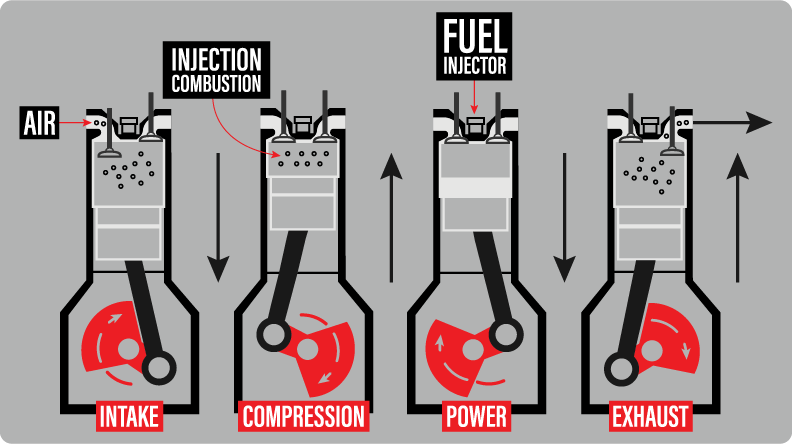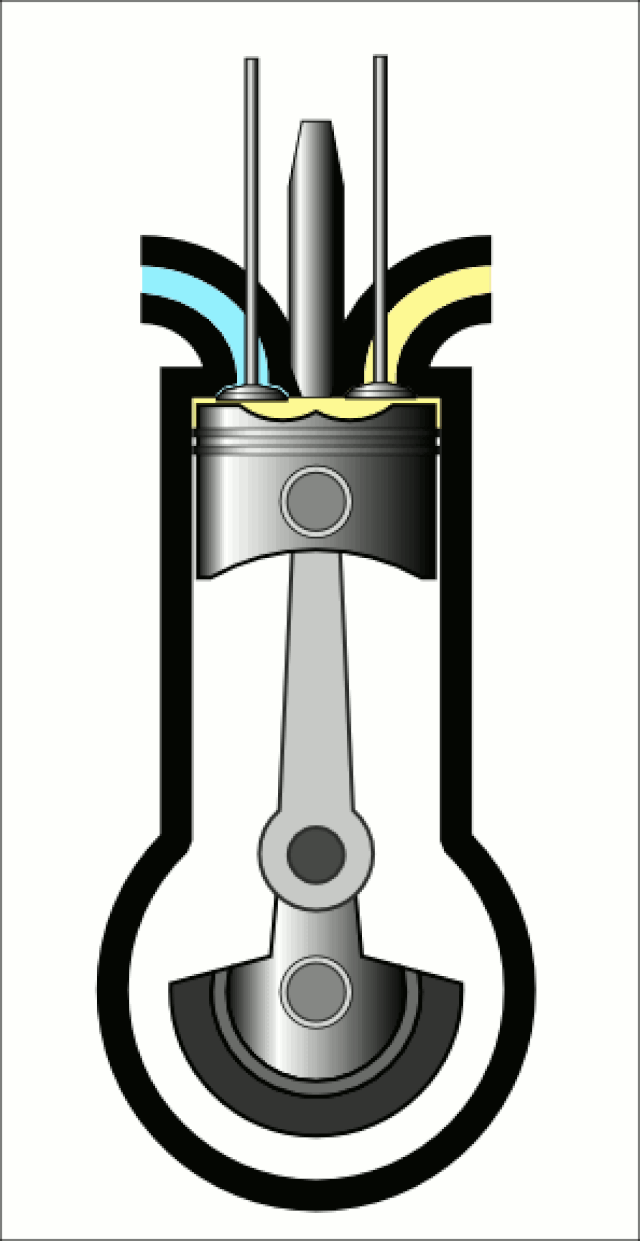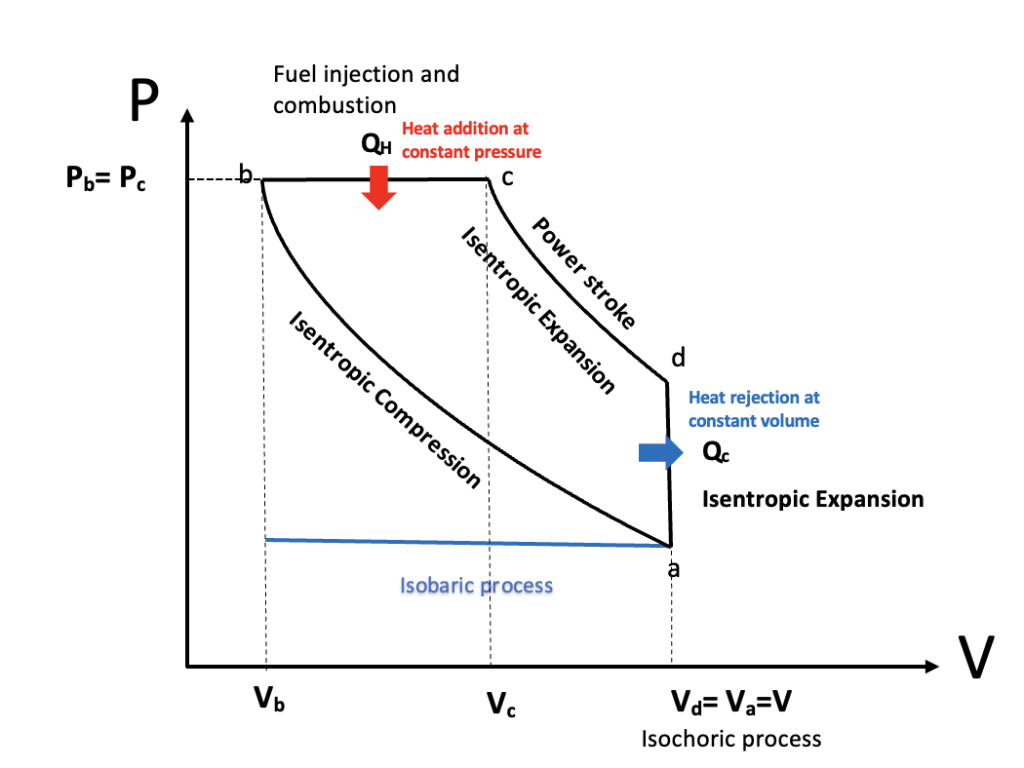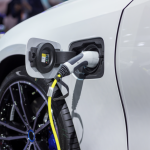
Did you know that there are two major types of automobile engines? Ones that run on petrol and the other that run on diesel. What’s interesting about the two fuels is that petrol can ignite easily with a spark. Hence petrol engines are also called spark ignition or SI engines. On the other hand, Diesel will not ignite with a simple spark. The ignition for diesel will take place only at very high pressure. This gives diesel engines the name compression-ignition or CI engines. The diesel cycle is named after the German inventor Rudolf Diesel. He proposed a thermodynamic process that explained the working of a diesel engine. Now then let’s see, how the Diesel cycle explains the workings of a CI engine.
Diesel Cycle Definition
Before we understand how it does this, let’s briefly look at the working of a CI engine – this will help you in relating to the processes of the Diesel cycle that we will be explaining in subsequent sections.
How do Diesel engines work?

This animation of a CI engine piston shows how the linear motion of the prison is converted into the rotation, which rotates the driveshaft to produce the power output. The 4 “strokes” of the cycle are also shown and will be explained later. Wikimedia Commons CC-BY-SA-3.0 There are three important parts that we need to know for us to understand the basic principle of how a CI engine works: The piston, the crankshaft, and the combustion chamber. The piston slides up and down, inside the combustion chamber. This chamber is sealed and airtight, and changes in volume as the piston slides up and down. The other end of the piston is connected to the crankshaft. Clever engineering converts the linear motion of the piston into rotation of the crankshaft which provides the power output of the engine. The most important difference between a gasoline engine and a diesel engine is in the ignition of the fuel. Diesel engines have a high compression ratio. This compresses the air-fuel mixture to very high pressure, usually assisted by a turbocharger. At this stage, the temperature of the fuel reaches a point where it can ignite without any spark plugs. Now let’s see how the chemical energy in Diesel fuel is converted into mechanical energy. The internal combustion engine takes four steps to achieve this. Each step is called a stroke as it represents a single upwards or downward motion of the piston.
Diesel cycle Process
The diesel cycle has four processes. These can each be observed in the animation above, and in the PV diagram in the next section.
- Process 1 [suction stroke] – This is when the piston first moves downward, creating a vacuum that sucks air into the combustion chamber.
- Process 2 [compression stroke] – Once the piston reaches the lowest point it moves up again and compresses the air in the combustion chamber to very high pressure. The pressure is so high that it heats up the air to beyond the temperature at which diesel ignites.
- Process 3 [power stroke] – The power stroke starts with a bang, as at the end of the compression cycle (process 2) the fuel is injected into the combustion chamber via the fuel injector. The fuel ignites as it mixes with the high-temperature air inside the chamber. This controlled explosion forces the piston back downwards producing work.
- Process 4 [exhaust stroke] – Finally, this is when the piston moves back up and pushes the by-products of combustion (mainly CO2 and heat) out of the combustion chamber. This is called the exhaust stroke. After this, the piston repeats process 1 and follows the same cycle once again.
Diesel Cycle Diagram
Now let’s explain the above paragraph in terms of thermodynamics. Here we have a PV (pressure-volume) diagram that depicts an ideal Diesel cycle. The processes mentioned above can be identified in the figure below.
PV Diagrams
PV Diagrams are used to graphically represent various different thermodynamic cycles. The pressure is measured on the y-axis and the volume is measured on the x-axis. This makes it a convenient way to represent the change in volume and pressure, which is usually important when we’re looking at thermodynamic cycles.
Here are a few important properties of the PV diagram:
The y-axis represents the pressure, and the x-axis represents the volume.
Increasing pressure values follow a down-to-up direction, and increasing volume values follow from left to right.
An arrow indicates the direction of the processes.
Some thermodynamic terms that are used to describe processes in PV diagrams are defined below:
An isobaric process is a thermodynamic process where pressure remains constant.
An adiabatic process is a thermodynamic process where there is no transfer of heat or mass to the surroundings.
An isentropic process is a thermodynamic process that is both adiabatic and reversible.
The ignition point is a temperature and pressure combination at which a fuel spontaneously ignites.
Diesel Cycle PV Diagram
Below we have a PV diagram that depicts a theoretically ideal Diesel cycle. The processes mentioned above can be identified in the figure below.

PV Diagram of a Diesel cycle, StudySmarter Originals
Now that you have an understanding of how a diesel engine operates, we will explain the working of the diesel engine using the diesel cycle.
Suction stroke
The horizontal blue line represents the suction stroke (intake stroke) – starting on the left of the blue line at volume, the volume of the chamber increases because the piston moves downward, drawing air into the combustion chamber. This process is isobaric as the pressure remains constant.
Compression stroke
Isentropic compression from a to b – this is the compression stroke we mentioned in the above section. The air gets compressed by the piston as it moves up and the combustion chamber volume decreases, increasing the pressure rapidly. However, there is no exchange of heat. This makes it an adiabatic process. The combustion chamber only contains air at this stage. Due to the increase in pressure, the air is heated beyond the ignition point of diesel.
Power stroke
Heat addition at constant pressure, b to c
This process covers the first part of the power stroke. Right before the beginning of the power stroke, the fuel injectors inject droplets of fuel into the combustion chamber. The contact between the diesel and heated air auto-ignites the mixture, with the controlled explosion driving the power stroke. The combustion of the fuel is completed at point c. The heat being added to the system is represented by QH . This process lasts for a very short amount of time. As the piston moves downwards to increase the combustion chamber volume during the power stroke, the heat added to the engine happens at a constant pressure. This makes it an isobaric process.
Isentropic expansion, c to d
This is the final part of the power stroke. The high pressure after the explosion continues to push down the piston, increasing the combustion chamber volume. Here the thermal energy from the combustion is converted into mechanical work. This process is also an adiabatic process.
Heat rejection at constant volume, d to a
This is where the heat is expelled from the combustion chamber as the piston reaches the bottom of the power stroke. The volume remains constant hence it is an isochoric process. The heat that is expelled is represented by QC. At this stage, the pressure also reduces significantly. This is very similar to the final process of the Otto cycle.
Exhaust stroke
The blue line in the opposite direction to the suction stroke represents the final exhaust stroke where the gases are expelled as the piston moves back upwards, ready to begin the cycle again.
Diesel Cycle Efficiency
The formula for the efficiency η of the Diesel cycle is given by the following equation.
A heat engine’s thermal efficiency is defined as the ratio of useful work done W, to the heat input at high temperature, QH.

In order to see how the thermal efficiency of an idealized diesel cycle changes when varying properties of the engine, there are two key ratios we can define; the cut-off ratio and the compression ratio.









